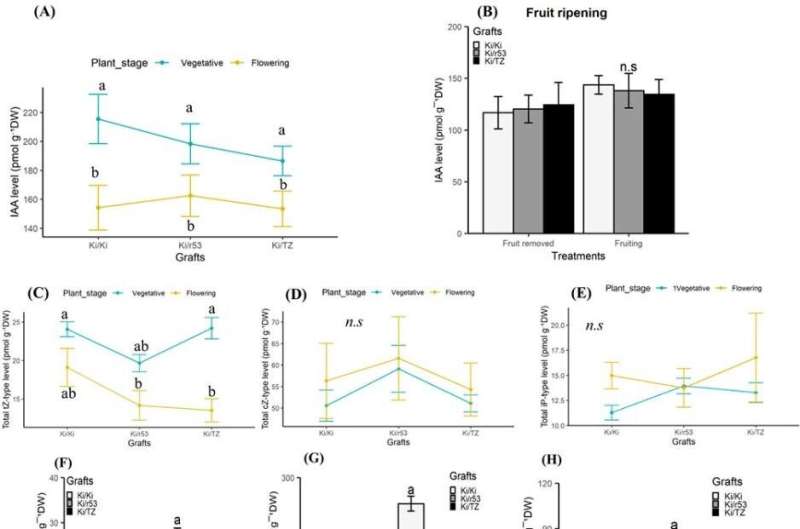
Grafting melon (Cucumis melon L.) onto pumpkin (Cucurbita maxima Duch. × Cucurbita moschata Duch.) rootstock is a method of improving yield but is challenged by the scion-rootstock incompatibility leading to plant collapse attributed to various physiological and biochemical factors.
Although initial beliefs that blockages in graft zones cause late-stage collapses, recent studies have shown that specific metabolites and hormone imbalances, particularly cytokinins and auxin (IAA), are more likely culprits.
These findings indicate a complex interplay of stress response and hormone regulation that disrupts the putative blockage mechanism and points towards metabolic and hormonal imbalances as the main factors inducing plant collapse, thus necessitating further research into the underlying physiological pathways.
Horticulture Research published research titled “Impairment of root auxin–cytokinins homeostasis induces collapse of incompatible melon grafts during fruit ripening.”
In this study, researchers conducted a series of hormone and metabolomic profiling, gene expression monitoring, and biochemical analyses of compatible and incompatible melon-pumpkin grafts under fruiting and fruitless conditions to understand the impact of grafting melon onto pumpkin rootstocks.
They found significant differences that emerged in the accumulation of certain leaf metabolites according to plant physiological stages, suggesting the rootstock genotype plays a role in metabolite accumulation.
This study revealed that the rate of collapse increased during fruit ripening due to early root senescence of incompatible graft roots and increased hydrogen peroxide content. Hormone profiling showed elevated levels of IAA, 2-oxoindole-3-acetic acid (IAA catabolite), indole-3-acetyl aspartic acid (IAA conjugate), and cis-zeatin-type cytokinins but lower levels of trans-zeatin-type cytokinins in the roots of incompatible combinations of plants during fruit ripening.
This suggested a disrupted hormone balance and potential blockage at the graft junction. Additionally, expression of the YUCCA gene, YUC2, YUC6, and YUC11 (required for auxin biosynthesis), the GRETCHEN-HAGEN3 gene (required for auxin conjugation), and the cytokinin oxidase/dehydrogenase 7 (CKX7) gene (which regulates the irreversible degradation of cytokinins) were enhanced in roots of incompatible combinations of plants during fruit ripening.
Further studies showed that the level of cytokinin oxidase/dehydrogenase, which degrades cytokinins, was higher in the roots of incompatible grafts. Moreover, high levels of IAA in the roots of the incompatible grafts during fruiting disrupt the balance between IAA and cytokinins, leading to oxidative stress and a reduction in photoassimilate transport from scion to rootstock.
H2O2 and MDA contents increased, and antioxidant enzyme activities decreased in the roots of the incompatible grafts during fruit ripening. The results suggest that the collapse of incompatible graft combinations during fruit ripening is closely associated with a dramatic accumulation of IAA in the root system, which may cause oxidative damage and disrupt the balance of IAA and cytokinins that is essential for the compatibility of melon-pumpkin grafts.
Overall, this study points to a complex interplay of hormonal imbalances, oxidative stress, and metabolite changes that leads to the collapse of incompatible melon-pumpkin grafts, especially during fruit ripening. This suggests the need for further research to understand the mechanisms behind graft incompatibility fully and to develop strategies to mitigate these effects for more successful grafting practices.
More information:
Maria Dolores Camalle et al, Impairment of root auxin–cytokinins homeostasis induces collapse of incompatible melon grafts during fruit ripening, Horticulture Research (2022). DOI: 10.1093/hr/uhac110
Provided by
Plant Phenomics
Citation:
Unraveling the complexity of melon-pumpkin graft collapse (2024, January 8)
retrieved 8 January 2024
from https://phys.org/news/2024-01-unraveling-complexity-melon-pumpkin-graft.html
This document is subject to copyright. Apart from any fair dealing for the purpose of private study or research, no
part may be reproduced without the written permission. The content is provided for information purposes only.

